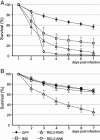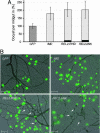Immune signaling pathways regulating bacterial and malaria parasite infection of the mosquito Anopheles gambiae
- PMID: 16076953
- PMCID: PMC1183586
- DOI: 10.1073/pnas.0504950102
Immune signaling pathways regulating bacterial and malaria parasite infection of the mosquito Anopheles gambiae
Abstract
We show that, in the malaria vector Anopheles gambiae, expression of Cecropin 1 is regulated by REL2, an NF-kappaB-like transcription factor orthologous to Drosophila Relish. Through alternative splicing, REL2 produces a full-length (REL2-F) and a shorter (REL2-S) protein isoform lacking the inhibitory ankyrin repeats and death domain. RNA interference experiments show that, in contrast to Drosophila Relish, which responds solely to Gram-negative bacteria, the Anopheles REL2-F and REL2-S isoforms are involved in defense against the Gram-positive Staphylococcus aureus and the Gram-negative Escherichia coli bacteria, respectively. REL2-F also regulates the intensity of mosquito infection with the malaria parasite, Plasmodium berghei. The adaptor IMD shares the same activities as REL2-F. Microarray analysis identified 10 additional genes regulated by REL2, including CEC3, GAM1, and LRIM1.
Figures






References
-
- Hoffmann, J. A. & Reichhart, J. M. (2002) Nat. Immunol. 3, 121-126. - PubMed
-
- Lemaitre, B., Nicolas, E., Michaut, L., Reichhart, J. M. & Hoffmann, J. A. (1996) Cell 86, 973-983. - PubMed
-
- Michel, T., Reichhart, J. M., Hoffmann, J. A. & Royet, J. (2001) Nature 414, 756-759. - PubMed
-
- Rutschmann, S., Jung, A. C., Hetru, C., Reichhart, J. M., Hoffmann, J. A. & Ferrandon, D. (2000) Immunity 12, 569-580. - PubMed
Publication types
MeSH terms
Substances
Grants and funding
LinkOut - more resources
Full Text Sources

